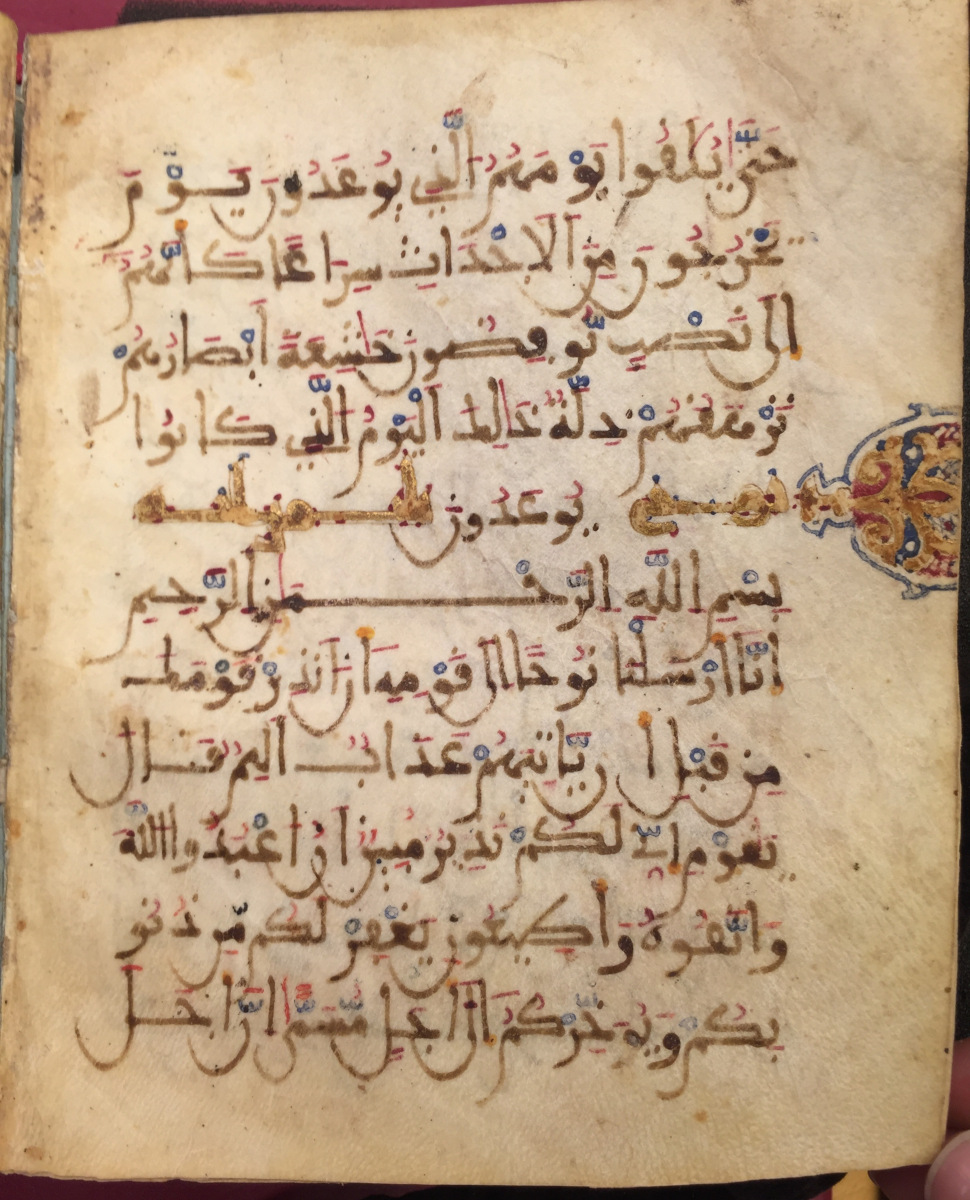
The Mukhtaṣar al-ʿAyn is the earliest Arabic dictionary to have survived from the medieval Islamic West.All dates are given first according to the Islamic calendar, then to the Gregorian. The romanisation of Arabic follows the transliteration system of the International Journal of Middle East Studies. Its author, Abū Bakr Muḥammad al-Zubaydī (d. 379/989), was a scholar from Seville who rose to become a courtier and confidant to al-Ḥakam II al-Mustanṣir bi-llāh (‘he who seeks victory in God’), the celebrated Umayyad caliph of Córdoba (r. 350/961–366/976),Sellheim (2002). who at the caliph’s request abridged and reworked the classical dictionary of the Iraqi grammarian al-Khalīl b. Aḥmad al-Farāhīdī (d. 170/791) into a compendium (mukhtaṣar in Arabic) that became immediately popular for its accuracy and conciseness. Zubaydī’s work is one of four lexicographic abridgements that were generally preferred to the original version.The most frequently cited edition of the Mukhtaṣar is Al-Zubaydī (1996), although this is based on a single manuscript copied in Cairo in 889/1484. For a discussion of the Mukhtaṣar’s contents, see Baalbaki (2014: 300–302).
Zubaydī completed his Mukhtaṣar al-ʿAyn in Córdoba in the summer of 362/973, for the library of al-Ḥakam II. The Umayyad caliph was a keen patron of knowledge and the arts, as well as a renowned bibliophile: a number of sources credit him with the establishment of a palatine library containing more than 400,000 books of all genres, which also functioned as an active centre for the study, copying, and the collation of literary works from all over the Islamic world and beyond.On the library of al-Ḥakam II, see Ribera y Tarragó ([1896] 1928: 192–95); Mazzoli-Guintard (2006); Puerta Vílchez (2007: 144–50). While the number 400,000 is likely a hyperbole, there is ample evidence suggesting that the caliphal library of Córdoba was one of the most important cultural hubs of its time. It is in this cosmopolitan intellectual milieu, animated by scholars from Baghdad and Constantinople, that Zubaydī worked as a philologist, poet, lexicographer, and the tutor of al-Ḥakam’s son and heir apparent Hishām. The original manuscript of the Mukhtaṣar al-ʿAyn is now lost, but at least six dated copies have survived from the following two centuries:
- Granada, Library of the Sacromonte, ms. árabe 2, on paper, dated 399/1008;Asín Palacios (1911: 255–56). See also Espejo Arias and Arias Torres (2005: 42–43).
- Madrid, Library of the CSIC, ms. RESC/35, on paper, dated 435/1043;Ribera y Tarragó and Asín Palacios (1912: 134–35, pl. 1); Koningsveld (1991: 819).
- Fes, Qarawiyyīn Library, ms. 1238, on parchment, dated 518/1124;Al-Fāsī (1979–1989: 3: 301–3, No. 1239).
- Rabat, National Library, ms. 6 Q, on paper, dated 524/1130;Al-Murābiṭī (2001–2002: 242–43, No. 247).
- Cairo, Azhariyya Library, ms. 1671 lugha, on paper, dated 583/1187;https://ketabpedia.com/تحميل/مخطوطة-مختصر-كتاب-العين-الزبيدي/ (accessed: March 2021).
- Marrakesh, Ibn Yūsuf Library, ms. 270/1, on paper, dated 600/1204.Ben Larbi (1994: 435, No. 1591), erroneously catalogued as the first volume of Ibn Sīda’s Muḥkam.
Of these early copies, the most precious and complete one is that of the Qarawiyyīn Library in Fes, dated 518/1124, which is the subject of this article.For the only (partial) edition of this manuscript, see Al-Zubaydī (1963). Many more undated manuscripts and fragments containing the text of Zubaydī’s Mukhtaṣar can be found in libraries across North Africa and the Middle East, demonstrating that its reputation endured well into the modern period.
History of the manuscript
The Mukhtaṣar al-ʿAyn of the Qarawiyyīn is a deluxe illuminated parchment codex, probably commissioned for the library of a wealthy patron or institution, and was most likely copied in Valencia. Its material value is evident when compared with other known manuscripts of the work, all of which were transcribed on cheap paper and lacked decoration, but the outstanding quality of this codex lies mainly in its pedigree: it was copied from a book that belonged to the celebrated grammarian Ibn al-Sīd al-Baṭalyawsī (444/1052–521/1127), who was living in Valencia at that time (Lévi-Provençal 1960). Baṭalyawsī’s copy had been transcribed directly from the lost original of al-Ḥakam II’s library, which bore glosses and a colophon written by Zubaydī himself.
As suggested by his name, Baṭalyawsī was born in Badajoz, but spent the last two decades of his life in Valencia, where he established a thriving circle of intellectuals who would gather at his house to read, discuss, and transcribe works of belles lettres, philology, and lexicography. This is evidenced by at least two other extant manuscripts: a copy of Baṭalyawsī’s own lexicographical treatise Al-Farq bayn al-Ḥurūf al-Khamsa (‘On the difference between the five letters’, ẓāʾ, ḍād, dhāl, ṣād, and sīn), dated to 512/1118 and transcribed by one of his pupils;Marrakesh, Ibn Yūsuf Library, ms. 134 (see Ben Larbi 1994: 433, No. 1583). The title page of this manuscript (f. 1a) bears a note written by Baṭalyawsī himself, certifying that the book was read back to him for verification, in Dhū al-Qaʿda 515/January 1122. This manuscript was copied by Aḥmad b. ʿUthmān b. Hārūn al-Lakhmī. and a copy of Ibn al-Sikkīt’s Kitāb al-Alfāẓ (‘Book of expressions’), which was read and collated in the presence of Baṭalyawsī, in 511/1117, ‘at his house in the city of Valencia’ (fī manzili-hi bi-madīnat Balansiyya).Fes, Qarawiyyīn Library, ms. 1240 (see Al-Fāsī 1979–1989: III: 304–305, No. 1241).
The Mukhtaṣar al-ʿAyn of the Qarawiyyīn can safely be attributed to the same scholarly milieu as these other manuscripts due to the information provided in its two colophons (Figs. 2, 3), which read as follows:
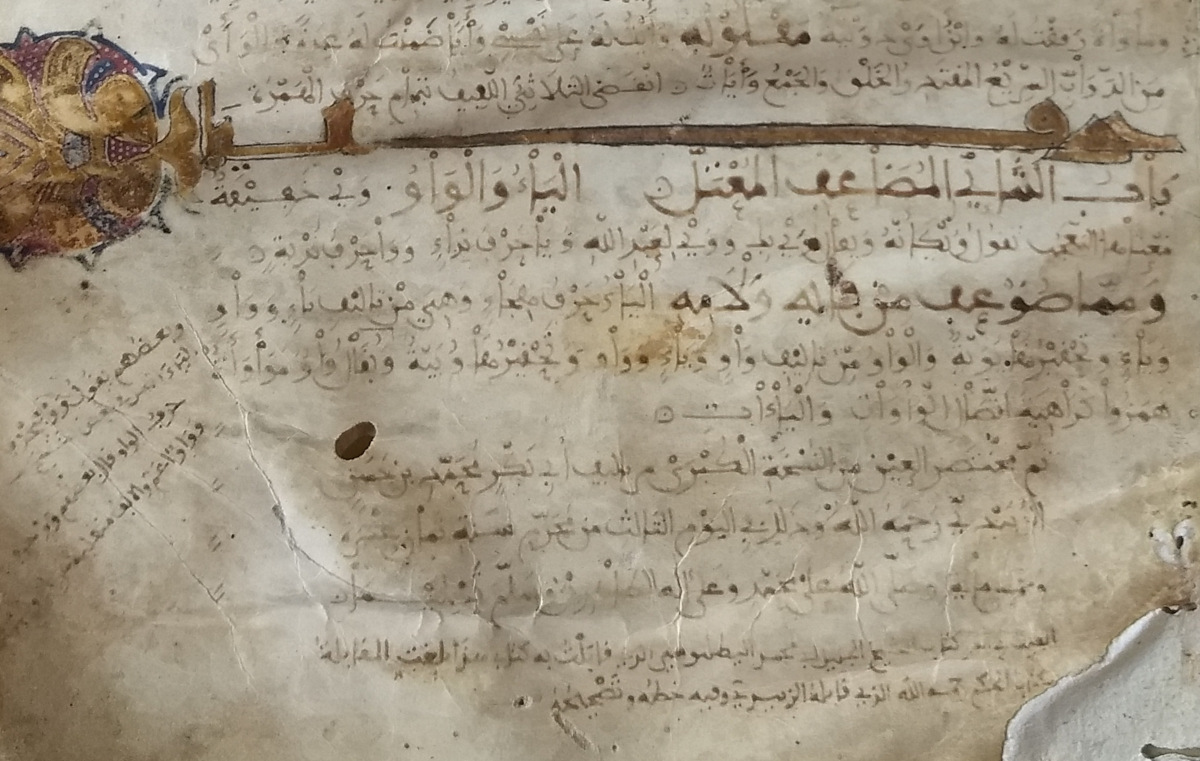
[Page 331]: End of the Mukhtaṣar al-ʿAyn, taken from the extended version, authored by Abū Bakr Muḥammad b. Ḥasan al-Zubaydī, God rest his soul. This occurred on the third of Muḥarram of the year 518 [21 February 1124], may God bless [the Prophet] Muḥammad and his pure family, and give him perfect peace. At the end of the manuscript of the venerable master Abū Muḥammad al-Baṭalyawsī, against which I have collated this copy of mine, I have found written: ‘Collated against the Book of al-Ḥakam [II], God rest his soul, which was collated by al-Zubaydī himself, and contained corrections in his handwriting’.
[Page 333]: At the end of the manuscript of the master Abū Muḥammad ʿAbd Allāh b. al-Ṣīd al-Baṭalyawsī (may God be pleased with him) I have found written by his brother (God rest his soul): ‘At the end of the Book of al-Ḥakam [II] al-Mustanṣir bi-llāh (may God be pleased with him) I have found written by Abū Bakr Muḥammad b. Ḥasan al-Zubaydī (God rest his soul): “I began to write this treatise in Rabīʿ I 362 [December 972], and I completed it and transcribed it for the first time, then collated it a second time, in Shawwāl of the same year [July 973]. The copying of the treatise was then entrusted to the servant of the Commander of the Faithful [i.e., al-Ḥakam II], al-Fatḥ b. ʿAmr b. Maṭar al-Ishbīlī”.’
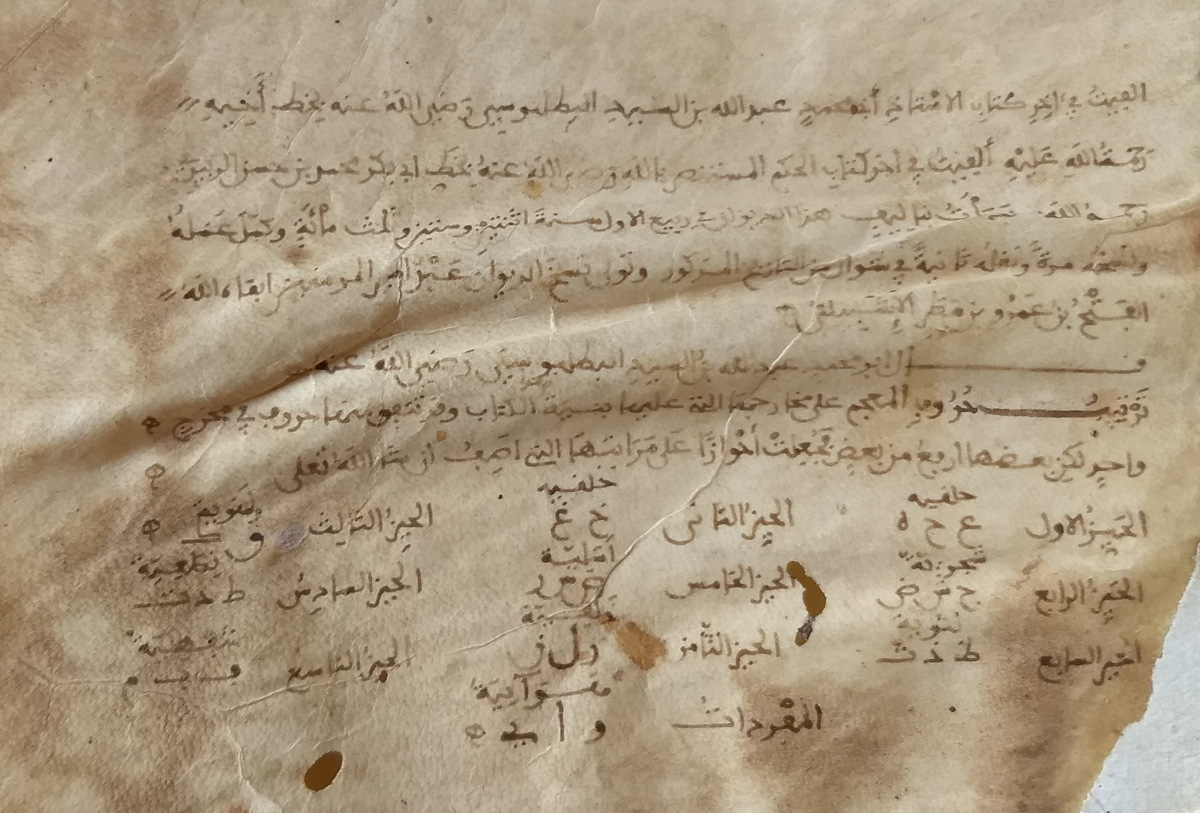
Zubaydi’s introduction to the Mukhtaṣar al-ʿAyn, which features in the Qarawiyyīn manuscript and in some later copies, provides further information on the aims of the work:
[Page 2]: This is a book whose compilation was ordered by the Commander of the Faithful al-Ḥakam [II] al-Mustanṣir bi-llāh, may God prolong his duration, because of his deep interest in knowledge and his desire to spread it and put it to good use. This book intends to be an abridgement of the book known as Kitāb al-ʿAyn, attributed to al-Khalīl b. Aḥmad al-Farāhīdī: [the lists of] his sources are here omitted, his prose is shortened, his digressions are suppressed, and all the superfluous and redundant parts are left out. The benefits of this work are thus revealed more fully, its memorization is facilitated, and its study is made easier for the student.
The authoritative tone of the Qarawiyyīn manuscript endows it with a special quality that was conveyed not only through its beautiful illuminations and meticulous calligraphy, but also through the unusual care the anonymous copyist gave to the articulation of its textual units: chapter headings, section titles, single entries and definitions, and marginal glosses. These textual units are separated from one another through a strikingly consistent punctuation system, while the marginal annotations are meticulously and creatively arranged so as to be easily identified and linked to the relevant passages of the main text. To fully understand the page architecture of the Mukhtaṣar al-ʿAyn of the Qarawiyyīn, it is first necessary to become familiar with a number of characteristics pertaining to Arabic as a language, and to the Arabic lexicographical tradition.
The structure of the Mukhtaṣar al-ʿAyn
Words in Arabic are formed from multi-consonantal roots and take vowels according to a series of fixed patterns. To arrange the letters of these roots in rational order, Zubaydī followed the system established in Khalīl’s Kitāb al-ʿAyn, though he introduced a few small changes. The system of arranging Arabic roots invented by Khalīl is called ‘phonetic-permutative’, and the letters of the Arabic alphabet are ordered according to where they are articulated within the human throat and mouth. The phonetic-permutative order of letters differs noticeably from the alphabetic one, and was only known to, and used by, linguists and philologists, but it is also the only one based on linguistic and phonetic principles. The arrangement of letters in Zubaydī’s Mukhtaṣar is as follows: ʿayn, ḥāʾ, hāʾ, khāʾ, ghayn, qāf, kāf, jīm, shīn, ḍād, ṣād, sīn, zāy, ṭāʾ, dāl, tāʾ, ẓāʾ, dhāl, thāʾ, rāʾ, lām, nūn, fāʾ, bāʾ, mīm, hamza, and yāʾ.For the phonetic-permutative system, see Baalbaki (2014: 280–82). This sequence is reiterated at the end of the colophon on page 333 of the manuscript (Fig. 3), where the letters are arranged into ten groups of two or three letters each, according to the memorization system recommended by Baṭalyawsī.
The number of radicals (i.e., consonants) in Arabic roots ranges between two and five. This morphological feature is reflected in the division of the Mukhtaṣar, as each chapter (ʿayn, ḥāʾ, hāʾ, khāʾ, etc.) is divided into four sections that begin with the biliteral roots and end with the quinqueliteral (if available). Permutations—different combination of radicals obtained by changing their order—are taken into account in each section: in biliteral words only two permutations are possible; in triliteral, quadriliteral and quinqueliteral words the number of possible permutations is six, 24, and 120 respectively, but only theoretically, as most of these combinations are not found in the language. The entries (lemmata) in Zubaydī’s Mukhtaṣar are restricted to roots that are in use, unlike in the Kitāb al-ʿAyn where Khalīl often lists unused permutations at the start of the biliteral and trilateral sections. Also noteworthy is the fact that, due to the principle of permutation, the letters coming first in the text include a much larger number of roots than those that come later. Because each root is listed according to the phonetic order of its radicals, the number of roots for successive letters gradually lessens. For example, the sections for mīm, hamza and yāʾ—the last three letters—occupy only two pages of the Qarawiyyīn manuscript, while the first three letters—ʿayn, ḥāʾ, and hāʾ—take up 131 pages in total.
Zubaydī’s abridgement of Khalīl’s dictionary led to the deliberate omission of numerous root derivatives, verbal forms, and usage examples taken from poetry, though a few examples from the Qurʾān and the Ḥadīth (sayings of the Prophet Muḥammad) were retained. Zubaydī reorganized some sections to facilitate internal consistency, designated new ones, and supplemented the text of the Kitāb al-ʿAyn with lexical items ignored by Khalīl (around 240 new entries; Baalbaki 2014: 300–302). Moreover, the colophons of this and other manuscripts of the Mukhtaṣar suggest that Zubaydī abridged Khalīl’s dictionary twice: first to produce an extended version of the digest (al-nuskha al-kubrā), and then to undertake a more synthetic abridgement (al-nuskha al-ṣughrā). The Qarawiyyīn manuscript is a copy of the latter, but with extensive marginal glosses that include examples and quotes from the former.Al-Zubaydī (1963, wāw-zāy). The colophon of the earliest known copy of the Mukhtaṣar (Granada, Library of the Sacromonte, ms. árabe 2, dated 399/1008) also states that the text was ‘taken from the extended version’ (Tamma Mukhtaṣar al-ʿayn min al-nuskha al-kubrā). Extant copies of this ‘extended edition’ have not yet been identified.
The page architecture of the Qarawiyyīn manuscript
The Mukhtaṣar al-ʿAyn of the Qarawiyyīn Library is a relatively small codex, measuring 24×16.5cm, bound in a modern leather cover. Apart from the first folio (a nineteenth-century paper replacement) the manuscript is complete and made up of 28 parchment ternions (i.e., quires of three bifolia each) arranged according to Gregory’s rule.Gregory’s rule is applied in parchment codices where the flesh side of a folio always faces another flesh side, and a hair side always faces another hair side: see Déroche (2005: 78–79). On each page, a text box measuring 18×11.7cm is scored in dry point to the left and right. There are 28 lines of text per page, and the upper margin of each recto is foliated in Fāsī digits, an idiosyncratic numbering system employed in Fes but originated in al-Andalus.On the Fāsī digits, also known as Rūmī, Zimāmī, or Toledan numerals, see Gacek (2009: 232) (s.v. ‘Rūmī/Fāsī numerals’); Colin (1933). Modern pagination in pencil is also present.
The best way to appreciate the complex page layout of the Qarawiyyīn manuscript is to think of how, and why, a well-to-do intellectual from twelfth-century Valencia would have used the book, and how the book interacts with its readers on multiple levels: some elements facilitate engagement with the text, while others add symbolic value and enhance the book’s aura of prestige. It should be borne in mind that the Arabic discussed in the Mukhtaṣar is a literary language, and not one used in spoken communication either in al-Andalus or elsewhere. A dictionary like Zubaydī’s would have been perused mainly to cultivate one’s erudition and appreciation of poetry and rhymed prose. The intended readers of such a manuscript may have been employed in a chancery—that of the Almoravid governor of Valencia, for instance—where the norms of official correspondence imposed the use of a particularly flowery language. Or they may simply have been affluent members of the city’s literary circles, wanting to find the best words (and correct pronunciations) with which to impress their peers at social events, such as poetic contests and dinner parties.
Page 303 of the Qarawiyyīn manuscript, depicted in Fig. 1, contains the final entries for the letter tāʾ and the first of those for ẓāʾ. For the sake of clarity, notable textual elements and subdivisions have been highlighted interactively.
The most conspicuous element is the chapter heading for the letter ẓāʾ on line 6. It is written in large Kufic script (an archaizing angular script typical of early Quranic manuscripts) which is illuminated in gold with black contours and red highlights. In the left margin is a polychrome vignette in the shape of a stylised flower, decorated in gold, red, and lapis lazuli blue. Twenty-seven similar chapter headings (ḥurūf, sing. ḥarf, ‘letters’) decorate the Qarawiyyīn manuscript, and all the marginal vignettes differ slightly from one another: some look more like budding flowers, others resemble palmettes, still others lobed medallions. The size and flamboyance of these chapter headings would have helped readers to navigate the text when searching for the word they had in mind, provided they had previously studied and memorized Zubaydī’s phonetic order of letters. The chapters have increasingly less content due to the aforementioned principle of permutation, which results in a climactic increase of illuminated headings towards the end of the manuscript—a sort of visual ‘final blaze’. Immediately before each illuminated heading, the end of the previous chapter is marked by a conclusive formula in medium-sized black Maghribī script, and a punctuation sign consisting of a dot enclosed in a circle. At the end of the last entry for the letter tāʾ, on lines 5–6, one can read: “the letter tāʾ ends here with the quadriliterals, as it has no quinqueliterals”. Maghribī scripts (also known as Maghribī round scripts) were the standard bookhands used when copying Arabic manuscripts in al-Andalus and the wider Islamic West (Maghrib).
Each chapter of the Mukhtaṣar comprises four sections (abwāb, sing. bāb) for the biliteral, triliteral, quadriliteral and quinqueliteral roots, introduced by headings in large black Maghribī script. On line 7, for instance, one can read: ‘section on duplicated sound biliterals’. Sections on triliteral roots are normally subdivided into three additional subsections: sound forms, forms with one weak radical, and forms with two weak radicals. These are also introduced by headings in large Maghribī script. On line 18, for example, one can read: ‘section on sound triliterals’. Headings and subheadings would have helped readers to recognize the section containing the word they sought, based on the number and type of radicals. The end of each section is marked by a conclusive formula in medium-size Maghribī script and the punctuation sign of a dot enclosed in a circle. Also on line 18, for instance, one can read: ‘end of the section on duplicated biliterals’. An alternative punctuation mark is a round letter hāʾ with a downward spur, the final letter of the word intahā (which means ‘finished’). This is found, for instance, at the end of line 3.
Each of the four sections is subdivided into roots, introduced by a heading specifying the letters they contain in large Maghribī script, such as the triliteral root ẓāʾ with rāʾ and fāʾ on line 21. This is where readers would have found the word they needed—e.g., the verb ẓarufa, meaning ‘to excel’, or the noun ẓarf, ‘a container for all sorts of things’—provided they had first considered all the possible permutations of its radicals. That is, if the word they were after contained ẓāʾ with ʿayn and nūn, they would not have found it under ẓāʾ, but in the first chapter dedicated to ʿayn, under the permutations of the radical combination ʿayn with ẓāʾ and nūn. Each root is followed by a section on its permutations, introduced by the word maqlūbu-hu in large Maghribī script. On line 23, for example, one can find the verb ẓaffara, meaning ‘to prick with one’s fingernail’, obtained by swapping the second and third radicals of the root ẓāʾ with rāʾ and fāʾ. For each root and permutation, the lemmata are listed in medium-size Maghribī script, with the usual dot-in-circle mark separating one from the next. Lines with blank spaces at the end are filled with two oblique pen strokes, to lend visual homogeneity to a text block. An interesting, if rather bizarre feature of page 303 is that the copyist seems to have initially forgotten to include the first biliteral root ẓāʾ with rāʾ. To remedy the omission, the same copyist added it in the right margin of the page, perpendicular to the main text, in miniature Maghribī script.
In all four margins are numerous additions, which appear as glosses written in miniature Maghribī script and creatively arranged in parallel, perpendicular, or zig-zagging lines. These marginalia contain additional lemmata, alternative pronunciations and spellings of certain words and their plurals, auxiliary meanings, and accepted uses. Some of these glosses are introduced by the letter kāf, which refers to the extended version of the Mukhtaṣar (called ‘al-nuskha al-kubrā’ in the colophon). The original manuscript by Zubaydī is also referred to as ‘aṣl Muḥammad’ and ‘kitāb Muḥammad’. Other glosses cite Khalīl’s original work, and refer to it as ‘al-kabīr’. Several other authorities are quoted, including the Sevillian grammarian Ibn al-Qūṭiyya (d. 367/977), and Abū ʿAlī al-Qālī, a celebrated philologist from Baghdad who had moved to Córdoba at the invitation of al-Ḥakam II and died there in 330/942 (Sellheim 1971). By way of example, the lemma maẓẓ on line 16 is succinctly defined as ‘wild pomegranate’, but a corresponding gloss in the left margin elaborates as follows: ‘Abū ʿAlī [al-Qālī transmits] from Abū Ḥanīfa, the author of al-Nabāt [’Book of Plants’], that the habitat of the maẓẓ is in the mountains, that it produces copious flowers, that in its blossoms is abundant honey, and that its honey is called madhkh, [spelled] with a dhāl and a khāʾ’. Through his activity, Qālī embodied the link between the eastern (Mashriqī) and western (Maghribī) lexicographical traditions, and it is significant that his work is so often quoted in these glosses, along with those of other famous eastern scholars such as Abū Ḥātim al-Sijistānī, Abū ʿUbayd Ibn Sallām, and Sībawayh. The punctuation mark used at the end of these marginalia is a letter ṣād, an abbreviation for the imperative form ṣil, ‘connect it!’, meaning ‘now continue to read from the main text’. The high number and intricate layout of these glosses, while admittedly precarious to navigate, enriched reader experience by providing windows into the work of authorities other than Zubaydī. Moreover, the zig-zag arrangement of some marginalia is an aesthetic choice that would have reminded readers of similar commentaries found in coeval religious manuscripts (Fig. 4). Almost every page of the Qarawiyyīn manuscript is inscribed with marginal notes such as those on page 303.
The text is interspersed with collation marks formed by the word ṣaḥḥa, meaning ‘it is correct’, placed atop certain words. On page 303 alone are 15 such marks. These were added once the copyist had checked particular words or passages against Baṭalyawsī’s original manuscript, and were meant to reassure the reader that the spelling and vocalization of the words had been carefully verified.
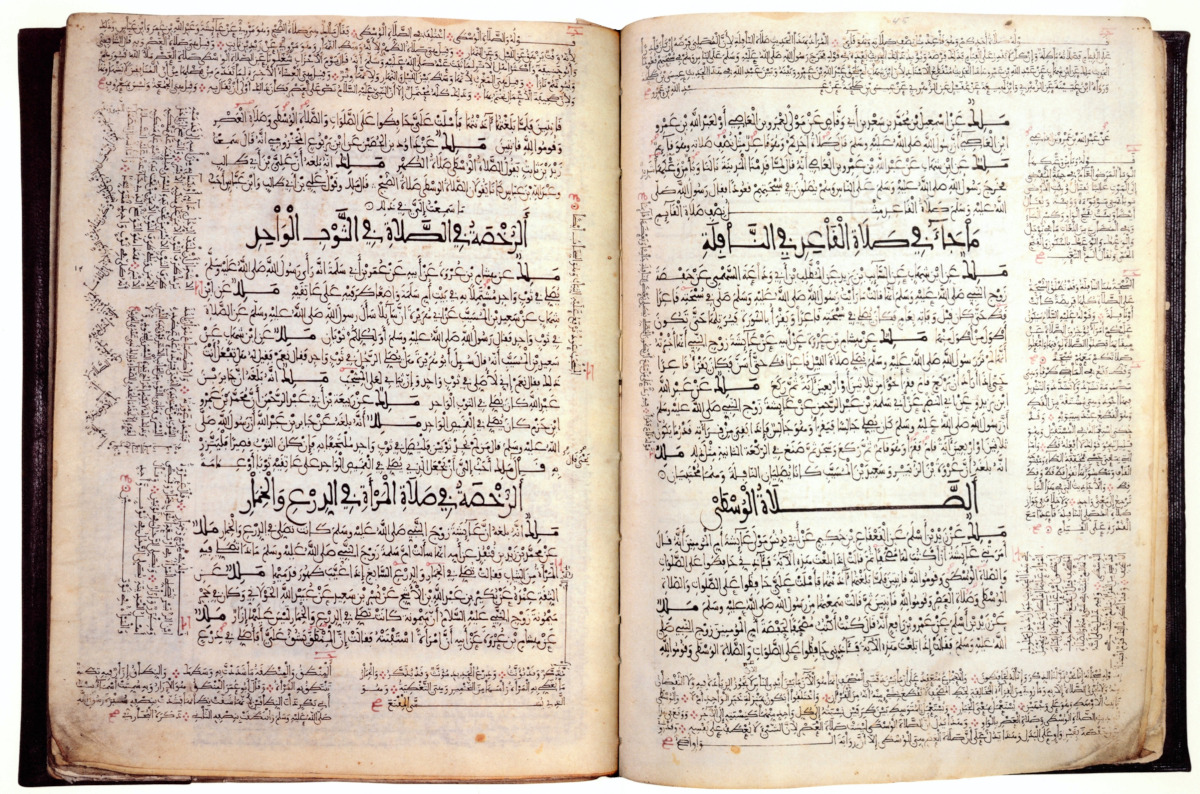
The page architecture of the Mukhtaṣar al-ʿAyn of the Qarawiyyīn Library seems to have simultaneously fulfilled three main functions, which can be best described as textual, symbolic, and aesthetic.
The three scripts of three different sizes reflect the three textual levels of the manuscript: headings to facilitate a reader’s search, entries to answer a reader’s lexical queries, and glosses as a critical apparatus to provide additional information concerning particularly difficult lemmata. The level of care that went into the articulation and demarcation of these textual layers—the copyist had to change pen 22 times to complete page 303 alone—must have made this manuscript a delight to use.
Symbolically, the presence of two colophons, regular collation marks, and copious glosses was meant to convey a sense of authoritativeness and reliability of the text. The chain of transmission and marginal commentary of the manuscript refer to the work of some of the greatest Andalusī grammarians and lexicographers (Zubaydī, Ibn al-Qūṭiyya, Baṭalyawsī himself), and to classical authors from the Islamic East (Sijistānī, Ibn Sallām, Sībawayh), with Qālī acting as a symbolic link between the two traditions. The aim was to present the reader with a prestigious summation of three hundred years of scholarship, which the Valencian school of Baṭalyawsī had rightfully inherited and transmitted.
Aesthetically, the gilded Kufic headings of the manuscript create a compelling visual connection with coeval illuminated religious books (especially Ḥadīth and Islamic jurisprudence). These too were written on parchment, and they too conveyed their authority through their meticulous calligraphy, their history of transmission, and their rich critical apparatus (Figs. 5, 6).For the illumination of Maghribī manuscripts from the twelfth century, see Barrucand (2005).
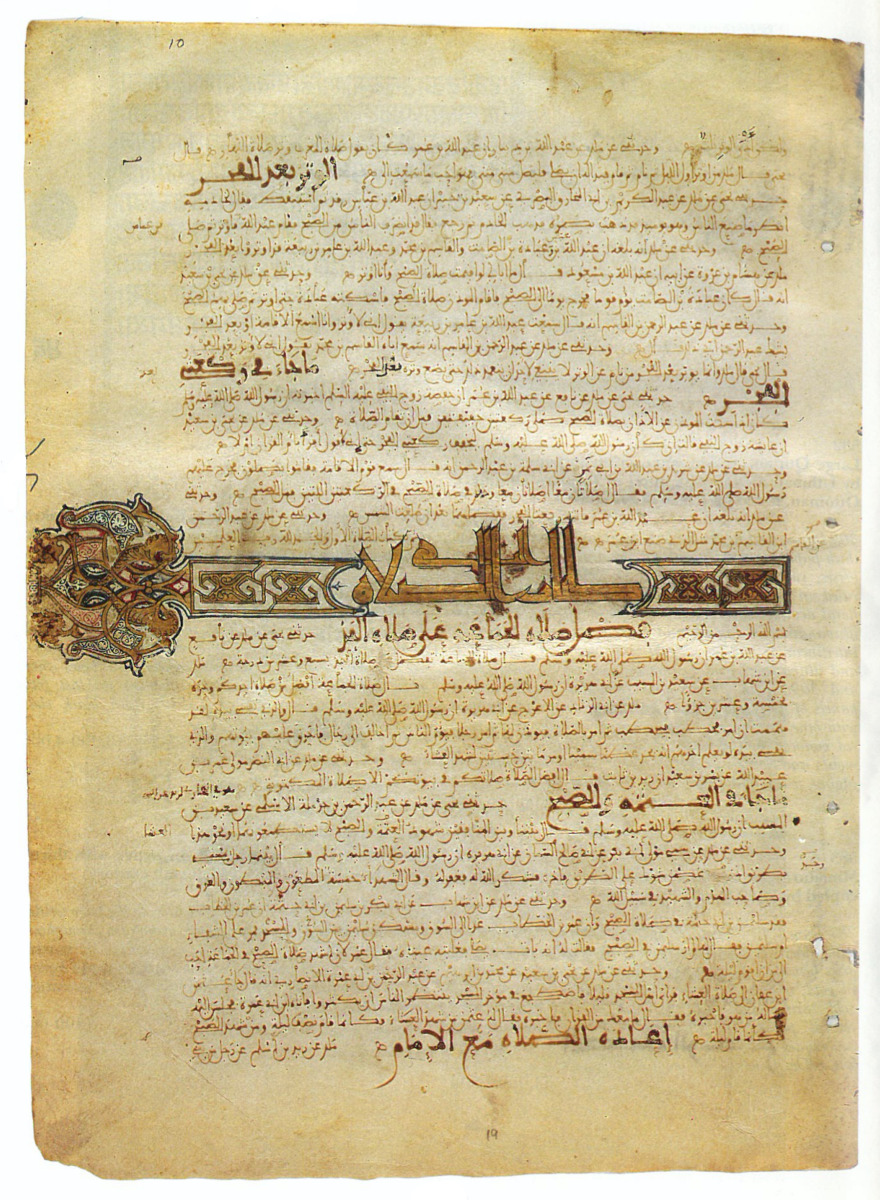
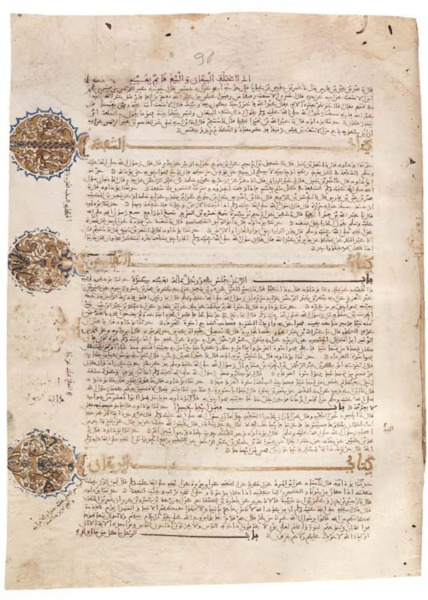
The Mukhtaṣar al-ʿAyn of the Qarawiyyīn is the earliest illuminated book on a non-religious subject to have survived from the Islamic West: one has to wait until the beginning of the thirteenth century to see gold appear again in a Maghribī manuscript other than a Qurʾān or a religious work.See the copy of the astrological treatise by ʿAbd al-Raḥmān al-Ṣūfī, Ṣuwar al-kawākib al-thābita (Rome, Vatican Library, ms. Ross. 1033) produced in Ceuta in 621/1244. New decorative styles were developed for specific genres of books in later periods, but the illumination of Andalusī luxury manuscripts during the eleventh and twelfth centuries closely imitated that of coeval Qurʾāns (Fig. 7), and intentionally so. In the case of religious works of Ḥadīth and Islamic jurisprudence, the aim was to enhance their numinous auras and elevate them to the same level as the Sacred Book. In the case of the Mukhtaṣar al-ʿAyn of the Qarawiyyīn, the aim was to create an exemplary book that would have functioned as an archetype for generations of Andalusī scholars, one that harked back to the golden age of al-Ḥakam II and his legendary library, and which visually celebrated the glories of the Andalusī lexicographic tradition.
